spare tire TOYOTA GT86 2020 Warranties & Maintenance Guides (in English)
[x] Cancel search | Manufacturer: TOYOTA, Model Year: 2020, Model line: GT86, Model: TOYOTA GT86 2020Pages: 260, PDF Size: 8.54 MB
Page 36 of 260
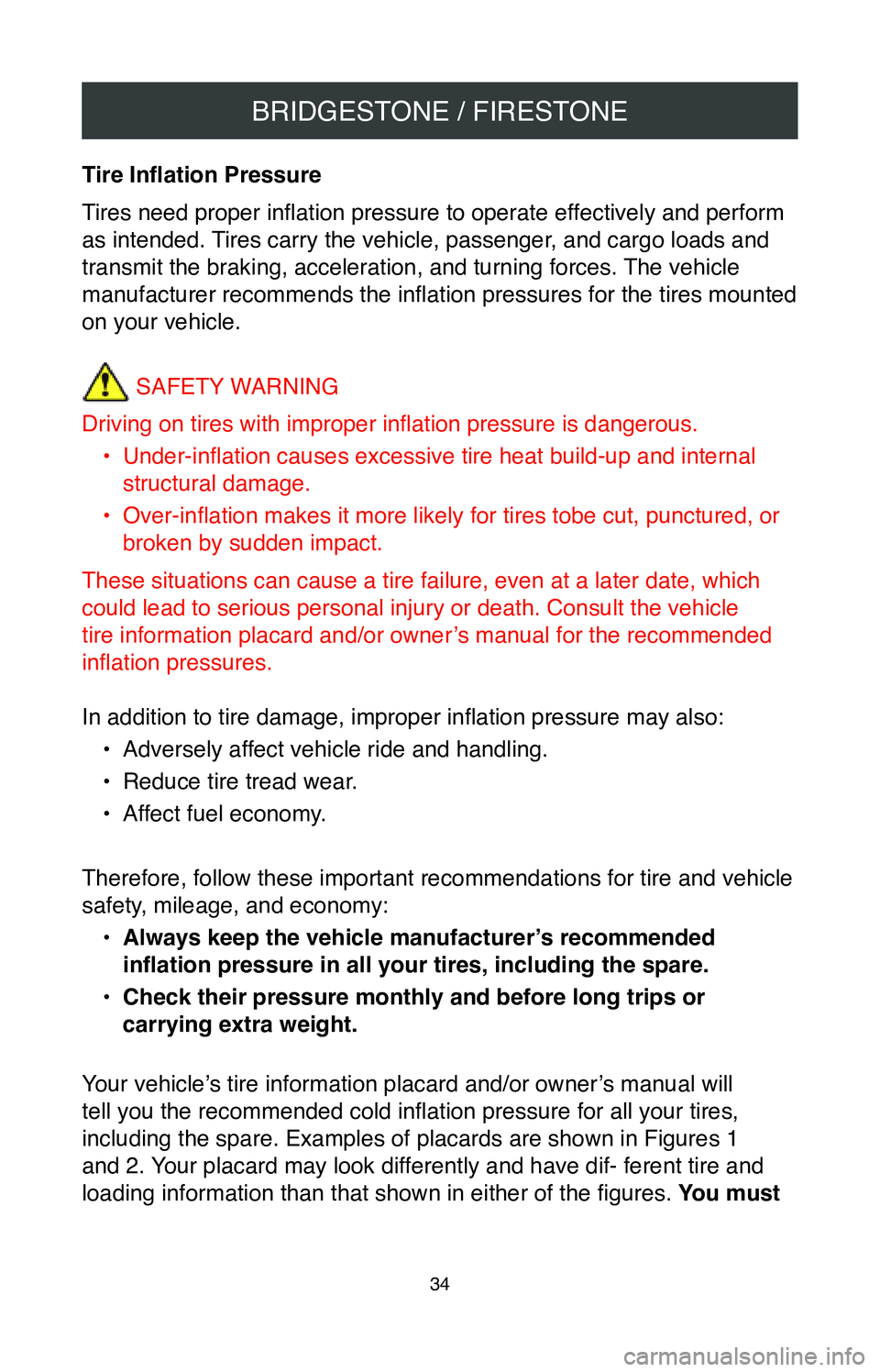
BRIDGESTONE / FIRESTONE
34
Tire Inflation Pressure
Tires need proper inflation pressure to operate effectively and perform
as intended. Tires carry the vehicle, passenger, and cargo loads and
transmit the braking, acceleration, and turning forces. The vehicle
manufacturer recommends the inflation pressures for the tires mounted
on your vehicle.SAFETY WARNING
Driving on tires with improper inflation pressure is dangerous. •
Under-inflation causes excessive tire heat build-up and internal
structural damage.
•
Over-inflation makes it more likely for tires tobe cut, punctured, or
broken by sudden impact.
These situations can cause a tire failure, even at a later date, which
could lead to serious personal injury or death. Consult the vehicle
tire information placard and/or owner’s manual for the recommended
inflation pressures.
In addition to tire damage, improper inflation pressure may also: •
Adversely affect vehicle ride and handling.
•
Reduce tire tread wear.
•
Affect fuel economy.
Therefore, follow these important recommendations for tire and vehicle
safety, mileage, and economy: •
Always keep the vehicle manufacturer’s recommended
inflation pressure in all your tires, including the spare.
•
Check their pressure monthly and before long trips or
carrying extra weight.
Your vehicle’s tire information placard and/or owner’s manual will
tell you the recommended cold inflation pressure for all your tires,
including the spare. Examples of placards are shown in Figures 1
and 2. Your placard may look differently and have dif- ferent tire and
loading information than that shown in either of the figures. You must
Page 38 of 260
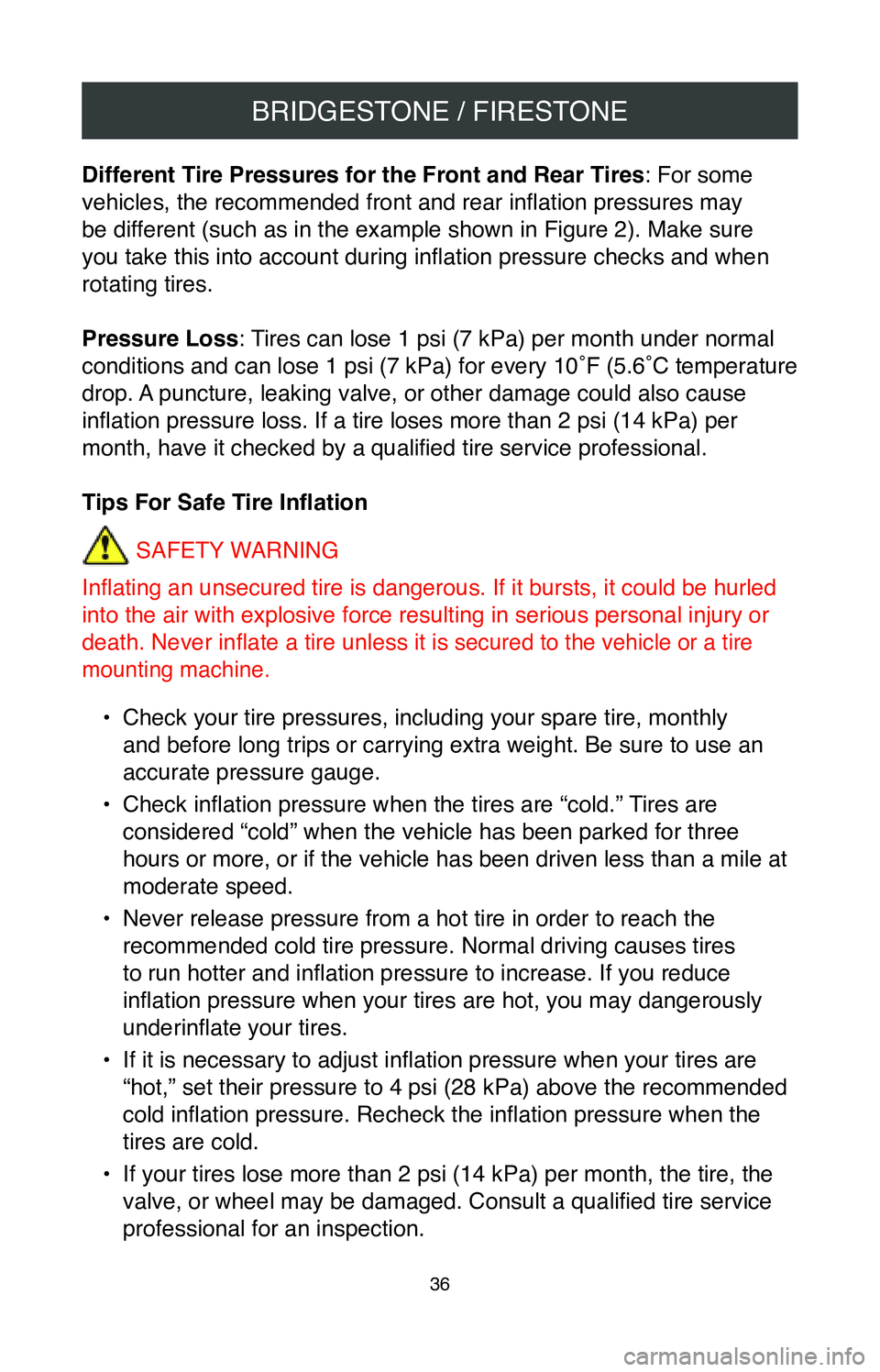
BRIDGESTONE / FIRESTONE
36
Different Tire Pressures for the Front and Rear Tires: For some
vehicles, the recommended front and rear inflation pressures may
be different (such as in the example shown in Figure 2). Make sure
you take this into account during inflation pressure checks and when
rotating tires.
Pressure Loss: Tires can lose 1 psi (7 kPa) per month under normal
conditions and can lose 1 psi (7 kPa) for every 10˚F (5.6˚C temperature
drop. A puncture, leaking valve, or other damage could also cause
inflation pressure loss. If a tire loses more than 2 psi (14 kPa) per
month, have it checked by a qualified tire service professional.
Tips For Safe Tire Inflation
SAFETY WARNING
Inflating an unsecured tire is dangerous. If it bursts, it could be hurled
into the air with explosive force resulting in serious personal injury or
death. Never inflate a tire unless it is
secured to the vehicle or a tire
mounting machine.
• Check your tire pressures, including your spare tire, monthly
and before long trips or carrying extra weight. Be sure to use an
accurate pressure gauge.
•
Check inflation pressure when the tires are “cold.” Tires are
considered “cold” when the vehicle has been parked for three
hours or more, or if the vehicle has been driven less than a mile at
moderate speed.
•
Never release pressure from a hot tire in order to reach the
recommended cold tire pressure. Normal driving causes tires
to run hotter and inflation pressure to increase. If you reduce
inflation pressure when your tires are hot, you may dangerously
underinflate your tires.
•
If it is necessary to adjust inflation pressure when your tires are
“hot,” set their pressure to 4 psi (28 kPa) above the recommended
cold inflation pressure. Recheck the inflation pressure when the
tires are cold.
•
If your tires lose more than 2 psi (14 kPa) per month, the tire, the
valve, or wheel may be damaged. Consult a qualified tire service
professional for an inspection.
Page 39 of 260
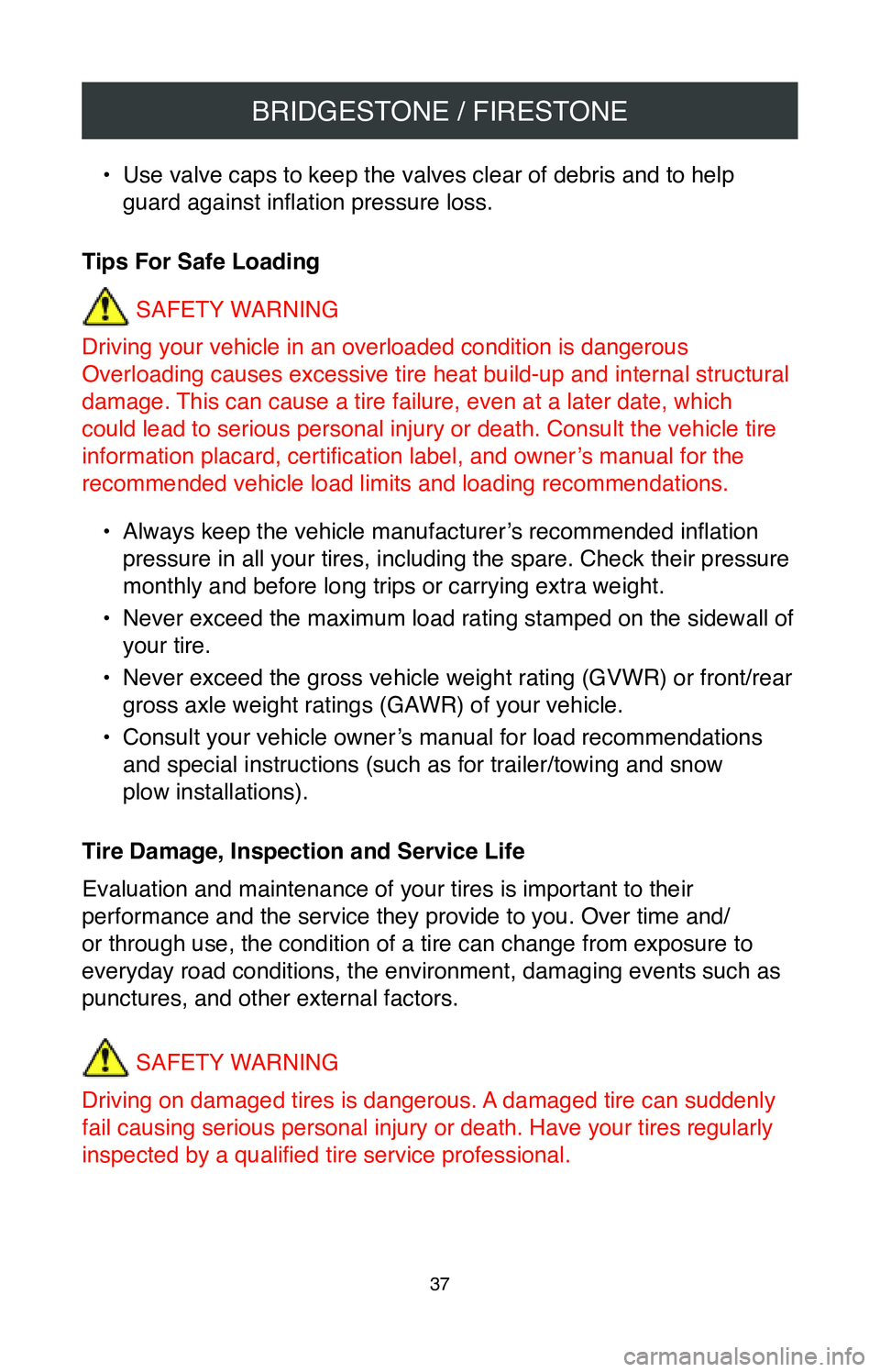
BRIDGESTONE / FIRESTONE
37
• Use valve caps to keep the valves clear of debris and to help
guard against inflation pressure loss.
Tips For Safe Loading SAFETY WARNING
Driving your vehicle in an overloaded condition is dangerous
Overloading causes excessive tire heat build-up and internal structural
damage. This can cause a tire failure, even at a later date, which
could lead to serious personal injury or death. Consult the vehicle tire
information placard, certification label, and owner’s manual for the
recommended vehicle load limits and loading recommendations.
•
Always keep the vehicle manufacturer’s recommended inflation
pressure in all your tires, including the spare. Check their pressure
monthly and before long trips or carrying extra weight.
•
Never exceed the maximum load rating stamped on the sidewall of
your tire.
•
Never exceed the gross vehicle weight rating (GVWR) or front/rear
gross axle weight ratings (GAWR) of your vehicle.
•
Consult your vehicle owner’s manual for load recommendations
and special instructions (such as for trailer/towing and snow
plow installations).
Tire Damage, Inspection and Service Life
Evaluation and maintenance of your tires is important to their
performance and the service they provide to you. Over time and/
or through use, the condition of a tire can change from exposure to
everyday road conditions, the environment, damaging events such as
punctures, and other external factors.
SAFETY WARNING
Driving on damaged tires is dangerous. A damaged tire can suddenly
fail causing serious
personal injury or death. Have your tires regularly
inspected by a qualified tire service professional.
Page 40 of 260
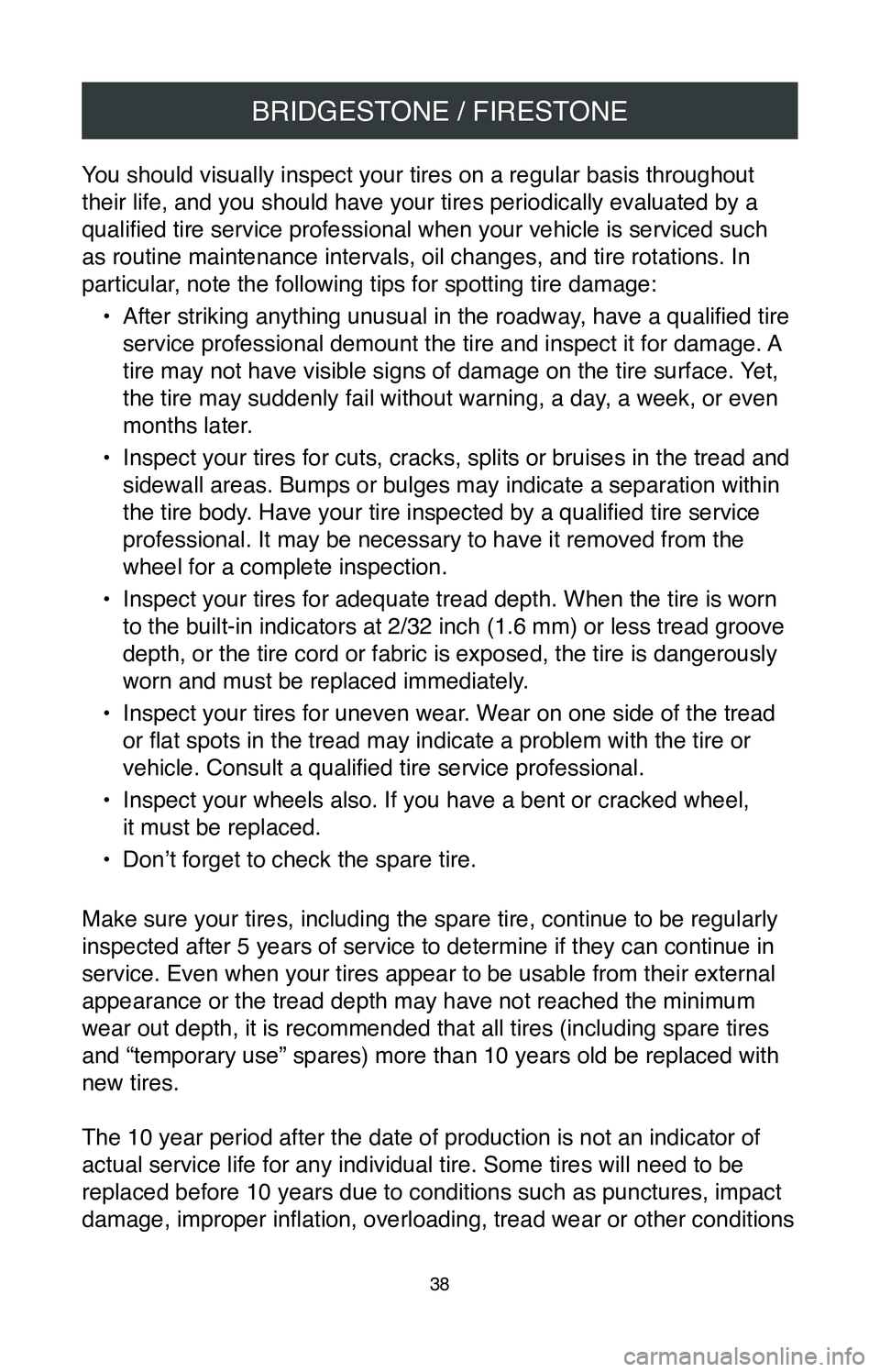
BRIDGESTONE / FIRESTONE
38
You should visually inspect your tires on a regular basis throughout
their life, and you should have your tires periodically evaluated by a
qualified tire service professional when your vehicle is serviced such
as routine maintenance intervals, oil changes, and tire rotations. In
particular, note the following tips for spotting tire damage:•
After striking anything unusual in the roadway, have a qualified tire
service professional demount the tire and inspect it for damage. A
tire may not have visible signs of damage on the tire surface. Yet,
the tire may suddenly fail without warning, a day, a week, or even
months later.
•
Inspect your tires for cuts, cracks, splits or bruises in the tread and \
sidewall areas. Bumps or bulges may indicate a separation within
the tire body. Have your tire inspected by a qualified tire service
professional. It may be necessary to have it removed from the
wheel for a complete inspection.
•
Inspect your tires for adequate tread depth. When the tire is worn
to the built-in indicators at 2/32 inch (1.6 mm) or less tread groove
depth, or the tire cord or fabric is exposed, the tire is dangerously
worn and must be replaced immediately.
•
Inspect your tires for uneven wear. Wear on one side of the tread
or flat spots in the tread may indicate a problem with the tire or
vehicle. Consult a qualified tire service professional.
•
Inspect your wheels also. If you have a bent or cracked wheel,
it must be replaced.
•
Don’t forget to check the spare tire.
Make sure your tires, including the spare tire, continue to be regularly\
inspected after 5 years of service to determine if they can continue in \
service. Even when your tires appear to be usable from their external
appearance or the tread depth may have not reached the minimum
wear out depth, it is recommended that all tires (including spare tires
and “temporary use” spares) more than 10 years old be replaced wi\
th
new tires.
The 10 year period after the date of production is not an indicator of
actual service life for any individual tire. Some tires will need to be \
replaced before 10 years due to conditions such as punctures, impact
damage, improper inflation, overloading, tread wear or other conditions
Page 50 of 260
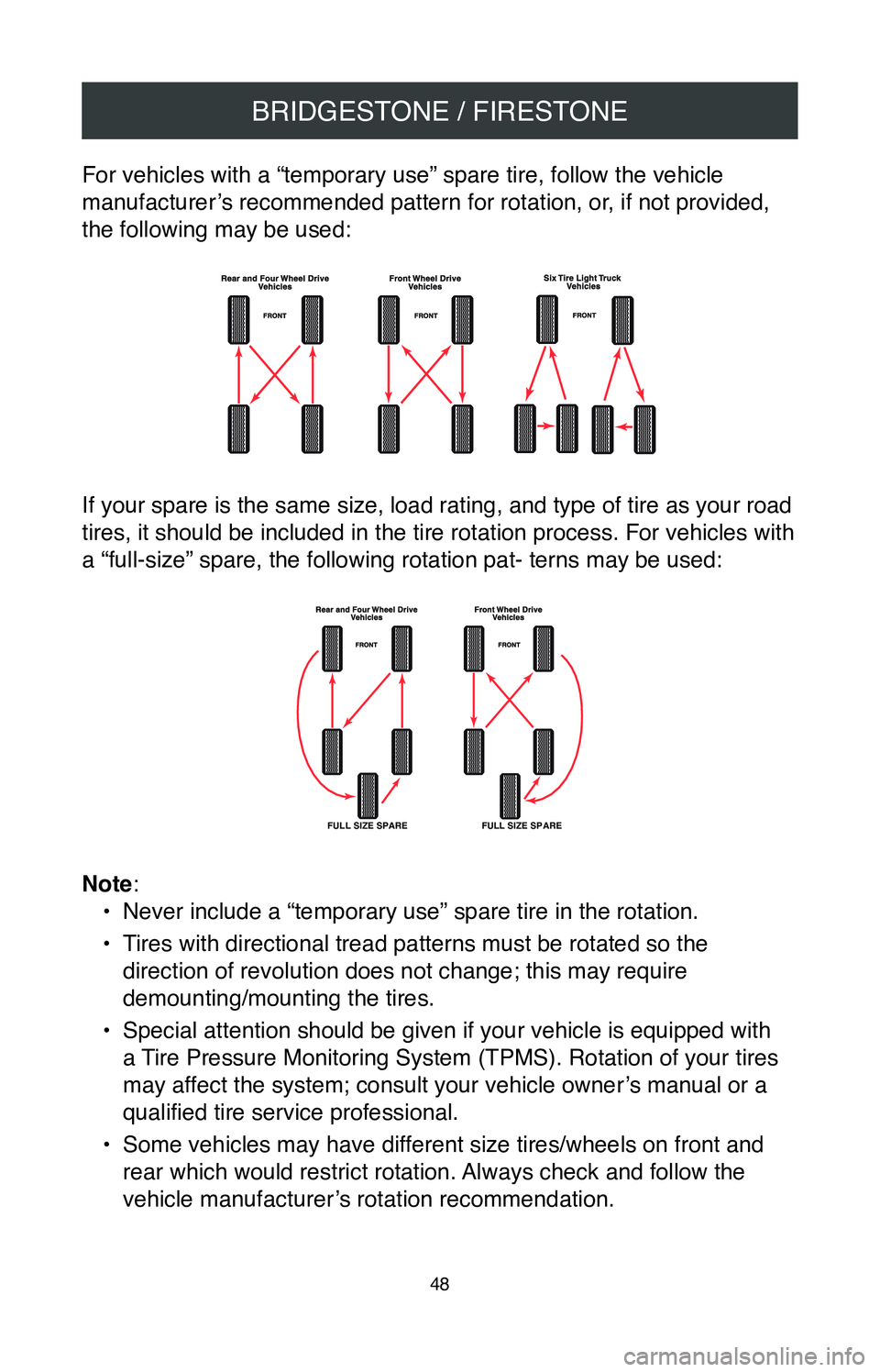
BRIDGESTONE / FIRESTONE
48
For vehicles with a “temporary use” spare tire, follow the vehicle\
manufacturer’s recommended pattern for rotation, or, if not provided,
the following may be used:
If your spare is the same size, load rating, and type of tire as your ro\
ad
tires, it should be included in the tire rotation process. For vehicles \
with
a “full-size” spare, the following rotation pat- terns may be used:
FULL SIZE SPAREFULL SIZE SPARE
Note:
•
Never include a “temporary use” spare tire in the rotation.
•
Tires with directional tread patterns must be rotated so the
direction of revolution does not change; this may require
demounting/mounting the tires.
•
Special attention should be given if your vehicle is equipped with
a Tire Pressure Monitoring System (TPMS). Rotation of your tires
may affect the system; consult your vehicle owner’s manual or a
qualified tire service professional.
•
Some vehicles may have different size tires/wheels on front and
rear which would restrict rotation. Always check and follow the
vehicle manufacturer’s rotation recommendation.
Page 51 of 260
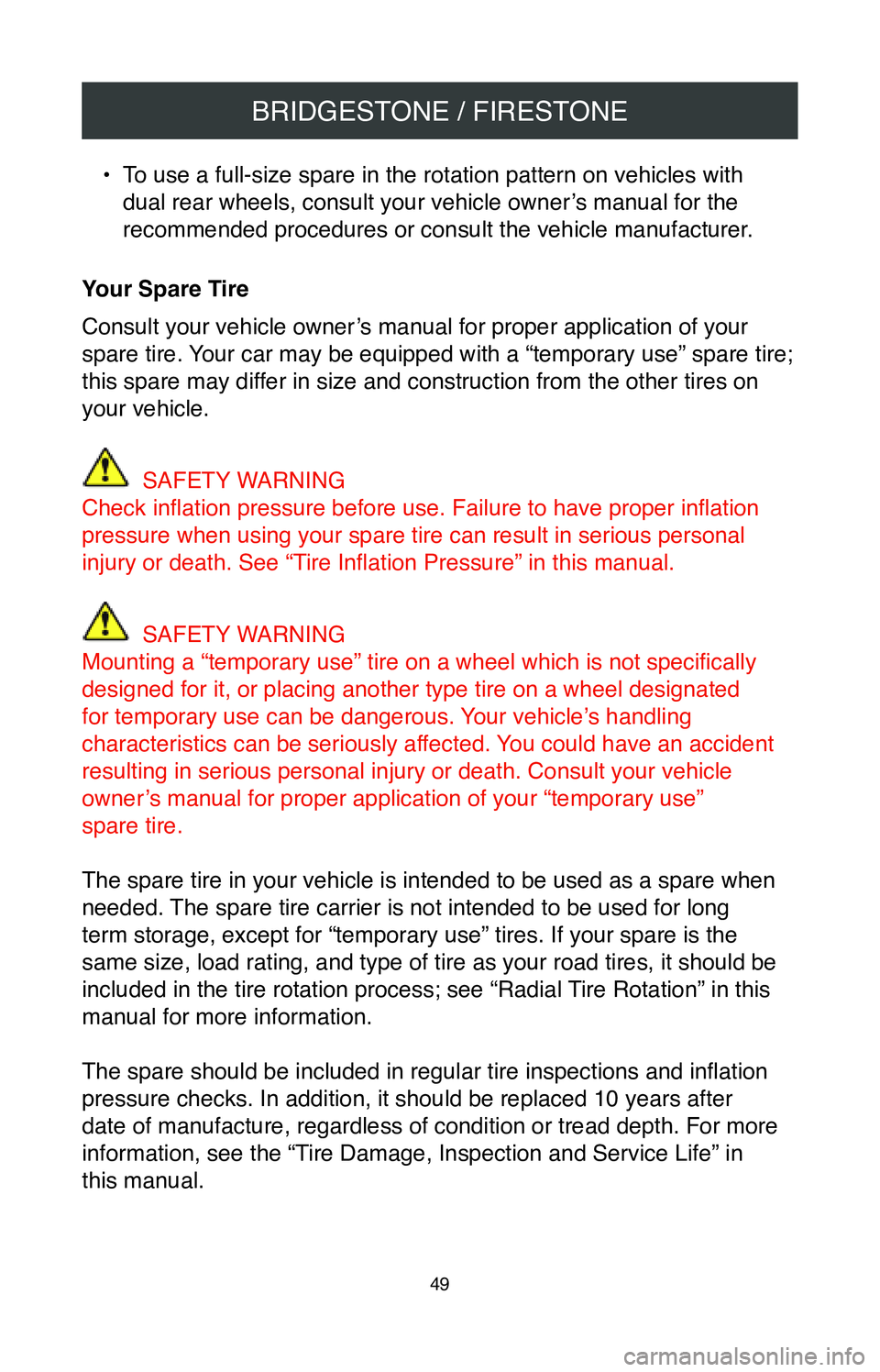
BRIDGESTONE / FIRESTONE
49
• To use a full-size spare in the rotation pattern on vehicles with
dual rear wheels, consult your vehicle owner’s manual for the
recommended procedures or consult the vehicle manufacturer.
Your Spare Tire
Consult your vehicle owner’s manual for proper application of your
spare tire. Your car may be equipped with a “temporary use” spare tire;
this spare may differ in size and construction from the other tires on
your vehicle.
SAFETY WARNING
Check inflation pressure before use. Failure to have proper inflation
pressure when using your spare tire can result in serious personal
injury or death. See “Tire Inflation Pressure” in this manual.
SAFETY WARNING
Mounting a “temporary use” tire on a wheel which is not specifically
designed for it, or placing another type tire on a wheel designated
for temporary use can be dangerous. Your vehicle’s handling
characteristics can be seriously affected. You could have an accident
resulting in serious personal injury or death. Consult your vehicle
owner’s manual for proper application of your “temporary use”
spare tire.
The spare tire in your vehicle is intended to be used as a spare when
needed. The spare tire carrier is not intended to be used for long
term storage, except for “temporary use” tires. If your spare is t\
he
same size, load rating, and type of tire as your road tires, it should b\
e
included in the tire rotation process; see “Radial Tire Rotation” in this
manual for more information.
The spare should be included in regular tire inspections and inflation
pressure checks. In addition, it should be replaced 10 years after
date of manufacture, regardless of condition or tread depth. For more
information, see the “Tire Damage, Inspection and Service Life” in
this manual.
Page 52 of 260
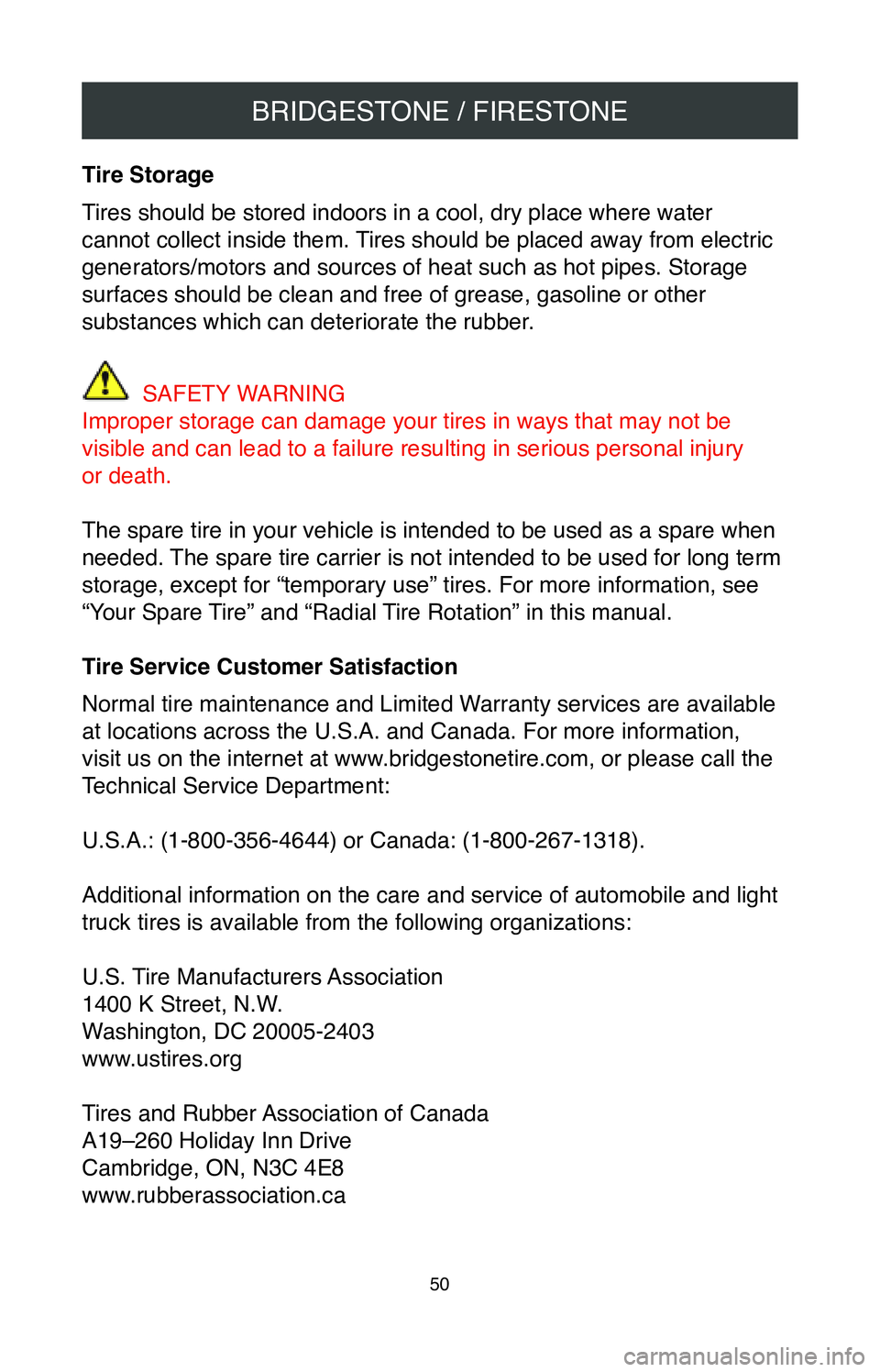
BRIDGESTONE / FIRESTONE
50
Tire Storage
Tires should be stored indoors in a cool, dry place where water
cannot collect inside them. Tires should be placed away from electric
generators/motors and sources of heat such as hot pipes. Storage
surfaces should be clean and free of grease, gasoline or other
substances which can deteriorate the rubber.
SAFETY WARNING
Improper storage can damage your tires in ways that may not be
visible and can lead to a failure resulting in serious personal injury
or death.
The spare tire in your vehicle is intended to be used as a spare when
needed. The spare tire carrier is not intended to be used for long term
storage, except for “temporary use” tires. For more information, s\
ee
“Your Spare Tire” and “Radial Tire Rotation” in this manual.
Tire Service Customer Satisfaction
Normal tire maintenance and Limited Warranty services are available
at locations across the U.S.A. and Canada. For more information,
visit us on the internet at www.bridgestonetire.com, or please call the
Technical Service Department:
U.S.A.: (1-800-356-4644) or Canada: (1-800-267-1318).
Additional information on the care and service of automobile and light
truck tires is available from the following organizations:
U.S. Tire Manufacturers Association
1400 K Street, N.W.
Washington, DC 20005-2403
www.ustires.org
Tires and Rubber Association of Canada
A19–260 Holiday Inn Drive
Cambridge, ON, N3C 4E8
www.rubberassociation.ca
Page 53 of 260
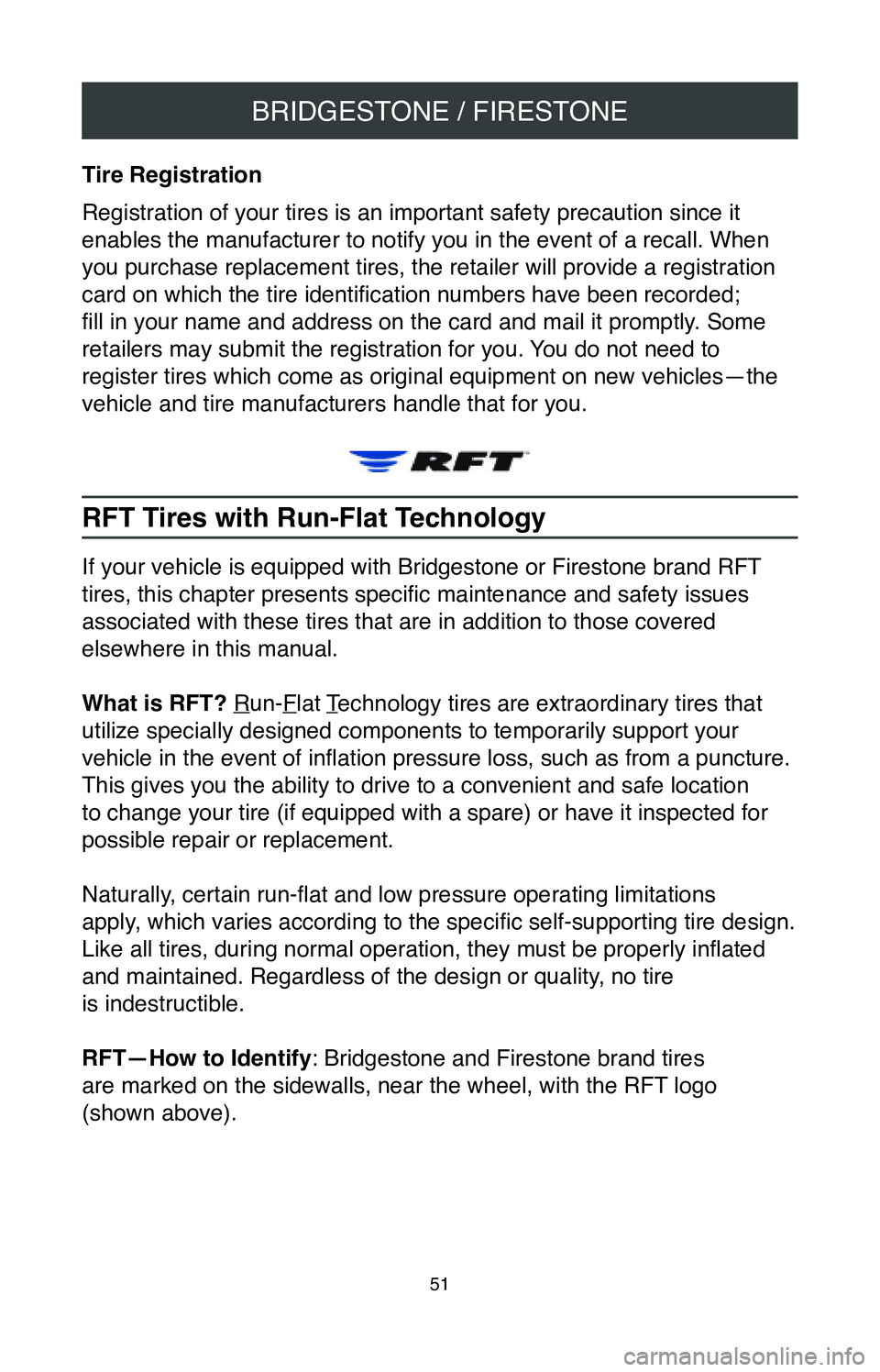
BRIDGESTONE / FIRESTONE
51
Tire Registration
Registration of your tires is an important safety precaution since it
enables the manufacturer to notify you in the event of a recall. When
you purchase replacement tires, the retailer will provide a registration\
card on which the tire identification numbers have been recorded;
fill in your name and address on the card and mail it promptly. Some
retailers may submit the registration for you. You do not need to
register tires which come as original equipment on new vehicles—the
vehicle and tire manufacturers handle that for you.
RFT Tires with Run-Flat Technology
If your vehicle is equipped with Bridgestone or Firestone brand RFT
tires, this chapter presents specific maintenance and safety issues
associated with these tires that are in addition to those covered
elsewhere in this manual.
What is RFT? Run-Flat Technology tires are extraordinary tires that
utilize specially designed components to temporarily support your
vehicle in the event of inflation pressure loss, such as from a puncture.
This gives you the ability to drive to a convenient and safe location
to change your tire (if equipped with a spare) or have it inspected for
possible repair or replacement.
Naturally, certain run-flat and low pressure operating limitations
apply, which varies according to the specific self-supporting tire design.
Like all tires, during normal operation, they must be properly inflated
and maintained. Regardless of the design or quality, no tire
is indestructible.
RFT—How to Identify : Bridgestone and Firestone brand tires
are marked on the sidewalls, near the wheel, with the RFT logo
(shown above).
Page 54 of 260
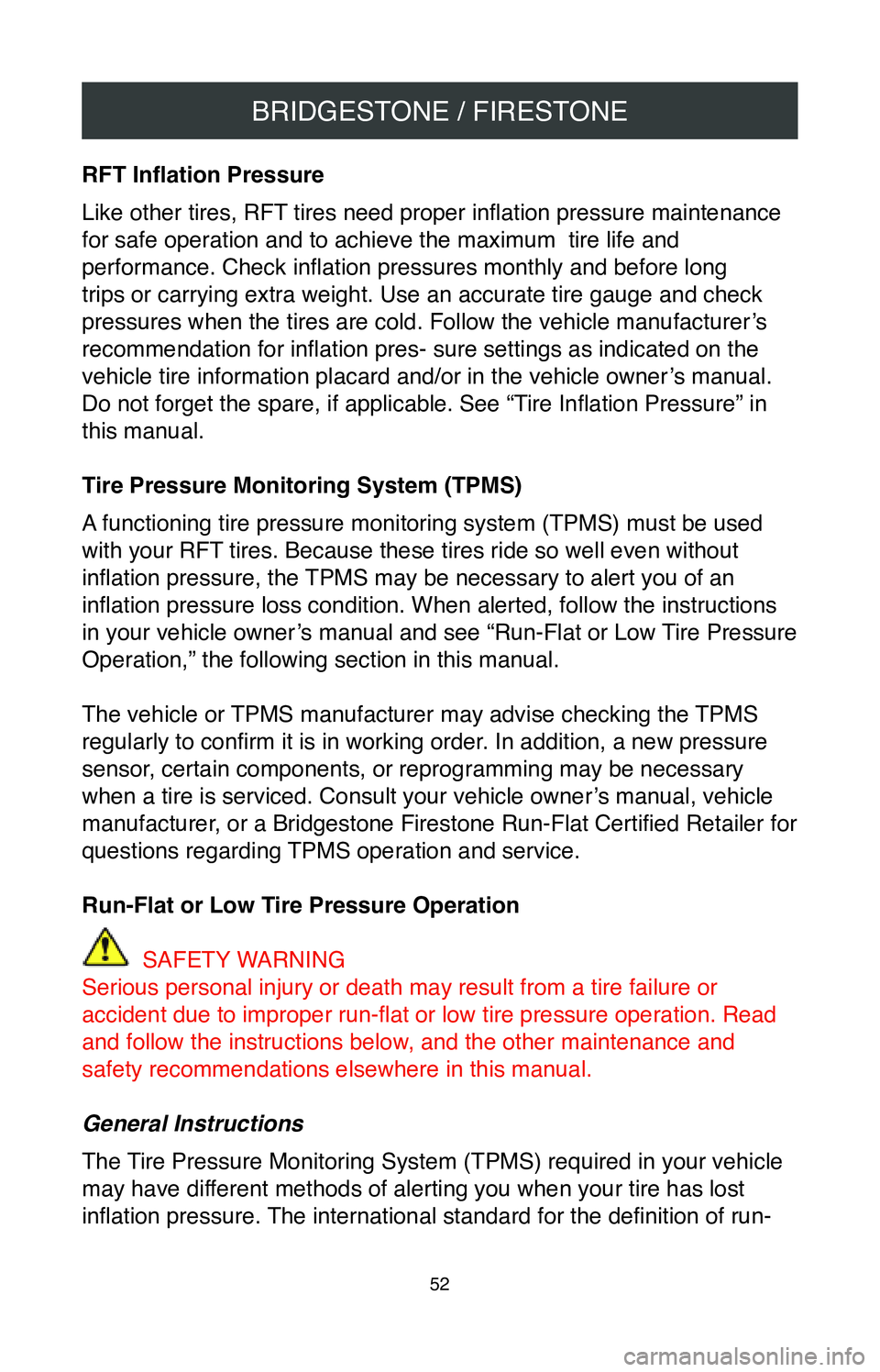
BRIDGESTONE / FIRESTONE
52
RFT Inflation Pressure
Like other tires, RFT tires need proper inflation pressure maintenance
for safe operation and to achieve the maximum tire life and
performance. Check inflation pressures monthly and before long
trips or carrying extra weight. Use an accurate tire gauge and check
pressures when the tires are cold. Follow the vehicle manufacturer’s
recommendation for inflation pres- sure settings as indicated on the
vehicle tire information placard and/or in the vehicle owner’s manual.
Do not forget the spare, if applicable. See “Tire Inflation Pressure” in
this manual.
Tire Pressure Monitoring System (TPMS)
A functioning tire pressure monitoring system (TPMS) must be used
with your RFT tires. Because these tires ride so well even without
inflation pressure, the TPMS may be necessary to alert you of an
inflation pressure loss condition. When alerted, follow the instructions
in your vehicle owner’s manual and see “Run-Flat or Low Tire Pressure
Operation,” the following section in this manual.
The vehicle or TPMS manufacturer may advise checking the TPMS
regularly to confirm it is in working order. In addition, a new pressure
sensor, certain components, or reprogramming may be necessary
when a tire is serviced. Consult your vehicle owner’s manual, vehicle
manufacturer, or a Bridgestone Firestone Run-Flat Certified Retailer for
questions regarding TPMS operation and service.
Run-Flat or Low Tire Pressure Operation
SAFETY WARNING
Serious personal injury or death may result from a tire failure or
accident due to improper run-flat or low tire pressure operation. Read
and follow the instructions below, and the other maintenance and
safety recommendations elsewhere in this manual.
General Instructions
The Tire Pressure Monitoring System (TPMS) required in your vehicle
may have different methods of alerting you when your tire has lost
inflation pressure. The international standard for the definition of run-
Page 62 of 260
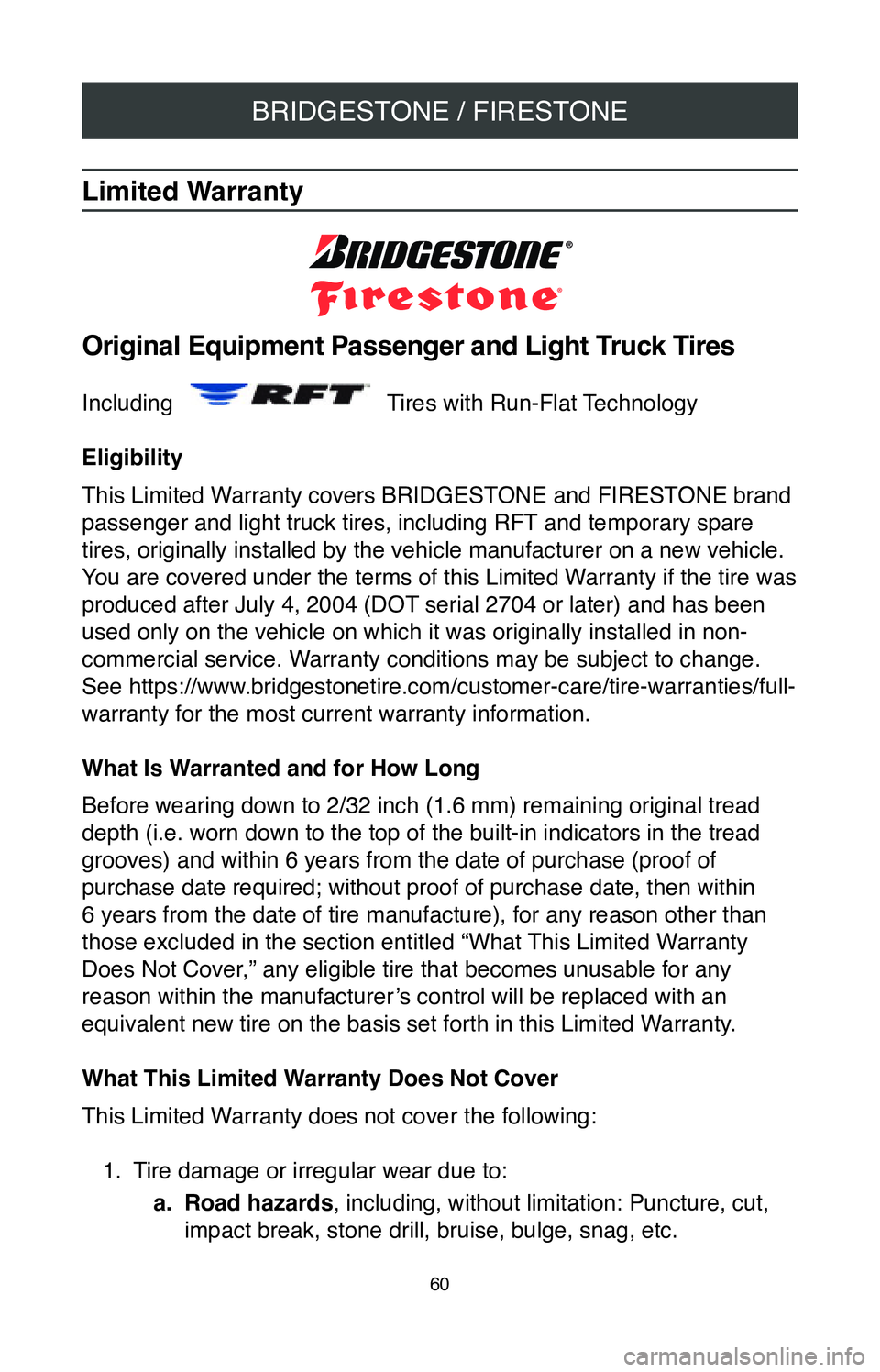
BRIDGESTONE / FIRESTONE
60
Limited Warranty
Original Equipment Passenger and Light Truck Tires
Including Tires with Run-Flat Technology
Eligibility
This Limited Warranty covers BRIDGESTONE and FIRESTONE brand
passenger and light truck tires, including RFT and temporary spare
tires, originally installed by the vehicle manufacturer on a new vehicle\
.
You are covered under the terms of this Limited Warranty if the tire was
produced after July 4, 2004 (DOT serial 2704 or later) and has been
used only on the vehicle on which it was originally installed in non-
commercial service. Warranty conditions may be subject to change.
See https://www.bridgestonetire.com/customer-care/tire-warranties/full-
warranty for the most current warranty information.
What Is Warranted and for How Long
Before wearing down to 2/32 inch (1.6 mm) remaining original tread
depth (i.e. worn down to the top of the built-in indicators in the tread
grooves) and within 6 years from the date of purchase (proof of
purchase date required; without proof of purchase date, then within
6 years from the date of tire manufacture), for any reason other than
those excluded in the section entitled “What This Limited Warranty
Does Not Cover,” any eligible tire that becomes unusable for any
reason within the manufacturer’s control will be replaced with an
equivalent new tire on the basis set forth in this Limited Warranty.
What This Limited Warranty Does Not Cover
This Limited Warranty does not cover the following: 1.
Tire damage or irregular wear due to:a.
Road hazards, including, without limitation: Puncture, cut,
impact break, stone drill, bruise, bulge, snag, etc.